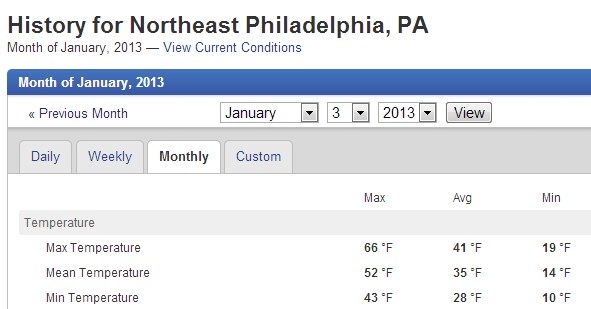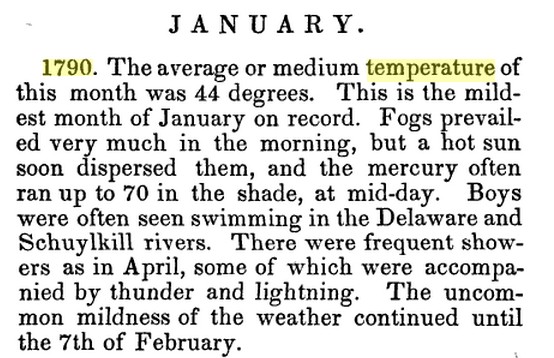Philadelphia averaged 35 degrees in January, 2012 – and 44 degrees in January, 1790.
A nine degree cool down since the Little Ice Age is exactly what the climate models predicted.
In 1790, pleasant weather was called mild. NOAA now classifies it as extreme.




A warm spell in winter used to considered good fortune and something to enjoy. Now it is considered “extreme weather” and something to agonize over.
Other EXTREME weather events for February 3 include –
1803
A great snowstorm dropped 20 inches of snow over the Winston-Salem area of North Carolina.
1844
Boston Harbor was so thick with ice on this date that a channel had to be cut through the ice for a ship to leave with 30,000 letters for England.
1917
A severe cold snap gripped areas from the Plains to Florida. Downtown Miami, FL reported an all-time record low of 27°. A few locations tied or broke record lows for February including: Athens, GA: 3°, Gainesville, FL: 17° and Key West, FL: 44°-Tied. Locations that reported daily record lows included: Sioux Falls, SD: -35°, Asheville, NC: -5°, Huntington, WV: 1°-Tied, Atlanta, GA: 2°, Roanoke, VA: 2°, Knoxville, TN: 2°, Lynchburg, VA: 3°-Tied, Greenville-Spartanburg, SC: 5°, Richmond, VA: 6°, Greensboro, NC: 7°, Birmingham, AL: 7°, Charlotte, NC: 8°, Augusta, GA: 9°, Columbia, SC: 9°, Raleigh, NC: 9°, Norfolk, VA: 9°, Montgomery, AL: 10°, Wilmington, NC: 13°, Savannah, GA: 13°, Meridian, MS: 13°, Tallahassee, FL: 15°, Jacksonville, FL: 16°, Pensacola, FL: 17°, Gainesville, FL: 17°, Ocala, FL: 18°, Waco, TX: 18°, Mobile, AL: 19°, Tampa, FL: 26°, West Palm Beach, FL: 28° and Fort Myers, FL: 33°.
1926
A tornado moved from Lake Worth to Palm Beach, FL killing one person and damaging 83 homes.
1936
Boston, MA reported their longest stretch with low temperatures of 10° or lower at 12, from 1/23 to 2/3/1936.
1947
Record cold gripped parts of Alaska. The temperature at Tanacross, AK plunged to a record low of -75°. Gulkana, AK set an all-time record low with -65°. McGrath and Fairbanks reported February record lows with -64° and -58° respectively. Locations that reported daily record lows included: King Salmon, AK: -32°, Homer, AK: -16°, Juneau, AK: -10° and Cold Bay, AK: -7°.
The temperature dropped to -81° at Snag, Northwest Territories Canada, North America’s lowest recorded official temperature, capping a week of intense cold in the Yukon. A temperature of -96° was recorded on 1/7/1982 near Summit Lake in British Columbia. While the recording was likely accurate it was not official.
The low temperature in Las Vegas was 27°. This marked the 32nd consecutive day with low temperatures at or below 32°, which is an all-time record.
1961
The 3rd through to the 5th, a large part of the Northeast and New England were reeling under their third great snowstorm of the winter. The Blizzard dumped 17.4 inches of snow on New York City, NY. Gale force winds blew the snow into 10 foot drifts that blocked city streets. Automobile travel was banned in New York City, NY for almost a week. Snowfall totals in other locations ranged from 10 to 24 inches in parts of Pennsylvania and 12 to 27 inches in parts of New Jersey. States of emergencies were declared. 73 people died as a result of the storm. Baltimore, MD set a record low with 4°.
Beginning January 20th, the daily low temperature at Albany, NY dropped to 0° or below for 15 consecutive days; a record for the location.
1963
High pressure across the Great Basin brought record heat to parts of the West. February’s record maximum temperature in the United States was set as Montezuma, AZ soared to 105°. Los Angeles (LAX), CA set their February record high with 92° and Big Bear Lake, CA hit 72°, tying their February record also set on 2/25/1986. Locations that reported daily record highs included: Yuma, AZ: 91°, Riverside, CA: 90°, Long Beach, CA: 90°, Palm Springs, CA: 90°, Downtown Los Angeles, CA: 88°, San Diego, CA: 85°-Tied, Santa Maria, CA: 84°, Palomar Mountain, CA: 73°, Eureka, CA: 72°, Reno, NV: 70°, Sacramento, CA: 68° and Stockton, CA: 68°.
Continuous strong northeast winds produced by a low pressure area east of the Florida coast generated high tides, rough surf and coastal flooding along entire northeast Florida coast from Nassau to Brevard Counties. Beaches sustained considerable erosion damage and some beach properties and roads were undermined.
1985
On this day and on the 4th, tornadoes hit the San Diego, CA neighborhoods of Tierrasanta and Allied Gardens. Eight mobile homes were damaged as well as other property. Funnel clouds were observed at Brown Field.
1986
A 5-day ice storm of freezing drizzle and fog through the 5th caused ice to accumulate 5 to 8 inches thick across central North Dakota. Many people were left without power. The ice in Wisconsin felled millions of trees.
1988
Arctic air continued to invade the central U.S. The temperature at Midland, TX plunged from a record high of 80° to 37° in just 3 hours. Morning lows in the higher elevations of Wyoming were as cold as -38°. Heavy snow blanketed southwestern Colorado, with 16 inches reported at Steamboat Springs.
1989
A winter storm brought heavy snow and high winds to the western U.S. Up to 3 feet of snow blanketed the Sierra Nevada of California, and buried parts of northeastern Washington State under 3 feet in five days. High winds across Washington State reached 75 mph, with gusts to 105 mph.
Severe cold gripped the north central U.S. Wisdom, MT fell to -53°. Missoula, MT reported a wind chill reading of -85°. Sheridan, WY set their February record low with -32°. Locations that reported daily record lows included: Helena, MT: -36°, Great Falls, MT: -35°, Casper, WY: -29°, Billings, MT: -26° (broke previous record by 12 degrees), Valentine, NE: -26°, Rapid City, SD: -23°, Missoula, MT: -22°, Denver, CO: -17°, Goodland, KS: -16°, Dodge City, KS: -13°, Topeka, KS: -8°, Wichita, KS: -7°-Tied, Clayton, NM: -6°, Amarillo, TX: -4°, Oklahoma City, OK: 0°, Tulsa, OK: 1° and Dallas, TX: 16°.
1990
Thunderstorms developing ahead of a cold front produced severe weather over the central Gulf coast states during the afternoon and evening hours. Thunderstorms spawned 7 tornadoes in Alabama, including one that touched down north of Birmingham injuring 15 people and causing nearly $3 million dollars damage. A tornado at Margaret injured 11 people and caused a million dollars damage.